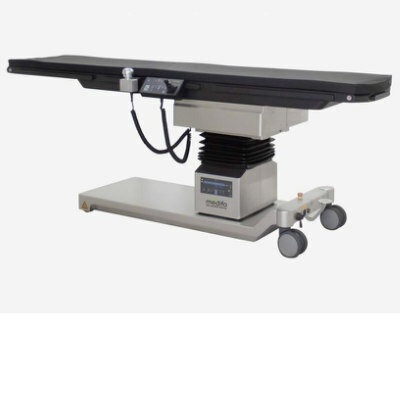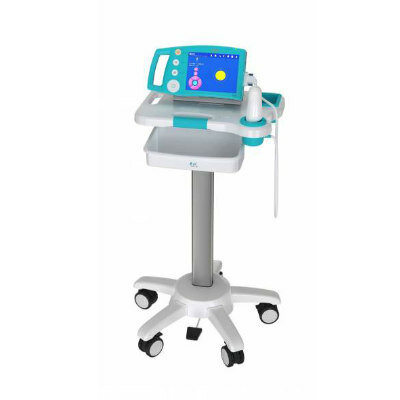Radiologists in Europe Launch Call for Action on Radiation Protection Measures
|
By MedImaging International staff writers Posted on 23 Oct 2014 |
A Europe-wide Call for Action campaign has been launched comprising 12 points, which include encouraging appropriateness in imaging, keeping radiation doses within diagnostic reference levels, using the as low as reasonably achievable (ALARA) principle, emphasizing the need for up-to-date equipment, empowering patients, and joining forces with other stakeholders.
The European Society of Radiology’s (ESR; Vienna, Austria) EuroSafe Imaging campaign’s all for Action is in support of the World Health Organization (WHO; Geneva, Switzerland) and International Atomic Energy Agency’s (IAEA; Vienna, Austria) Bonn (Germany) Call for Action launched in 2012.
Work has already begun on implementing many of these points, as the ESR is currently working on introducing a clinical decision support system and is developing templates for internal clinical audit. It also provides significant e-learning resources, which cover topics in radiation protection, as well as educational sessions. In terms of empowering patients, the ESR has founded the Patient Advisory Group for Medical Imaging, which is chaired by the head of the European Patients’ Forum, Nicola Bedlington.
The EuroSafe Imaging campaign was launched by the ESR in response to the ever-increasing number of radiologic exams being performed yearly. With an increasing number of exams comes higher overall radiation exposure in absolute terms, so it is vital to keep doses as low as possible and to ensure the most appropriate radiologic exam is used in each and every case.
“This initiative is necessary, but also is very timely, because we are now facing, worldwide, a challenge to deal with the potential risks of radiation in healthcare without compromising the benefits, and this is the reason why I think it is very appropriate that this initiative is taken by the professionals; the radiologists,” said Dr. Maria Del Rosario Perez, from the WHO.
The Call for Action is the latest step taken by the ESR as part of EuroSafe Imaging. It is aimed at ensuring that medical imaging in Europe remains safe and continues to offer its vital benefits to patients. To do this, the campaign needs the support of radiologists, radiographers, and any medical professional involved in medical imaging throughout Europe. By implementing the 12 points in the EuroSafe Imaging Call for Action, they can help make Europe the safest place for patients to have a radiological exam.
All stakeholders in medical imaging are affected by this Call for Action as EuroSafe Imaging reflects the ESR’s inclusive and objective approach to improving radiation safety. “We believe that this holistic approach is an important step towards joining forces for patient safety in Europe. And we believe too that the use of up-to-date equipment is of utmost importance for improving the safety of X-ray examinations. The ESR urges the European Commission to develop a European plan for the improvement of X-ray equipment, including CT [computed tomography] across Europe,” said Guy Frija, founder of EuroSafe Imaging, chair of the EuroSafe Imaging Steering Committee and ESR past president.
EuroSafe Imaging is the European Society of Radiology’s latest campaign to promote quality and safety in medical imaging. The objective of EuroSafe Imaging is to support and strengthen medical radiation protection across Europe following a holistic, inclusive approach. Watch this video to learn more about EuroSafe Imaging.
Related Links:
European Society of Radiology
EuroSafe Imaging
World Health Organization
The European Society of Radiology’s (ESR; Vienna, Austria) EuroSafe Imaging campaign’s all for Action is in support of the World Health Organization (WHO; Geneva, Switzerland) and International Atomic Energy Agency’s (IAEA; Vienna, Austria) Bonn (Germany) Call for Action launched in 2012.
Work has already begun on implementing many of these points, as the ESR is currently working on introducing a clinical decision support system and is developing templates for internal clinical audit. It also provides significant e-learning resources, which cover topics in radiation protection, as well as educational sessions. In terms of empowering patients, the ESR has founded the Patient Advisory Group for Medical Imaging, which is chaired by the head of the European Patients’ Forum, Nicola Bedlington.
The EuroSafe Imaging campaign was launched by the ESR in response to the ever-increasing number of radiologic exams being performed yearly. With an increasing number of exams comes higher overall radiation exposure in absolute terms, so it is vital to keep doses as low as possible and to ensure the most appropriate radiologic exam is used in each and every case.
“This initiative is necessary, but also is very timely, because we are now facing, worldwide, a challenge to deal with the potential risks of radiation in healthcare without compromising the benefits, and this is the reason why I think it is very appropriate that this initiative is taken by the professionals; the radiologists,” said Dr. Maria Del Rosario Perez, from the WHO.
The Call for Action is the latest step taken by the ESR as part of EuroSafe Imaging. It is aimed at ensuring that medical imaging in Europe remains safe and continues to offer its vital benefits to patients. To do this, the campaign needs the support of radiologists, radiographers, and any medical professional involved in medical imaging throughout Europe. By implementing the 12 points in the EuroSafe Imaging Call for Action, they can help make Europe the safest place for patients to have a radiological exam.
All stakeholders in medical imaging are affected by this Call for Action as EuroSafe Imaging reflects the ESR’s inclusive and objective approach to improving radiation safety. “We believe that this holistic approach is an important step towards joining forces for patient safety in Europe. And we believe too that the use of up-to-date equipment is of utmost importance for improving the safety of X-ray examinations. The ESR urges the European Commission to develop a European plan for the improvement of X-ray equipment, including CT [computed tomography] across Europe,” said Guy Frija, founder of EuroSafe Imaging, chair of the EuroSafe Imaging Steering Committee and ESR past president.
EuroSafe Imaging is the European Society of Radiology’s latest campaign to promote quality and safety in medical imaging. The objective of EuroSafe Imaging is to support and strengthen medical radiation protection across Europe following a holistic, inclusive approach. Watch this video to learn more about EuroSafe Imaging.
Related Links:
European Society of Radiology
EuroSafe Imaging
World Health Organization
Latest General/Advanced Imaging News
- New AI Method Captures Uncertainty in Medical Images
- CT Coronary Angiography Reduces Need for Invasive Tests to Diagnose Coronary Artery Disease
- Novel Blood Test Could Reduce Need for PET Imaging of Patients with Alzheimer’s
- CT-Based Deep Learning Algorithm Accurately Differentiates Benign From Malignant Vertebral Fractures
- Minimally Invasive Procedure Could Help Patients Avoid Thyroid Surgery
- Self-Driving Mobile C-Arm Reduces Imaging Time during Surgery
- AR Application Turns Medical Scans Into Holograms for Assistance in Surgical Planning
- Imaging Technology Provides Ground-Breaking New Approach for Diagnosing and Treating Bowel Cancer
- CT Coronary Calcium Scoring Predicts Heart Attacks and Strokes
- AI Model Detects 90% of Lymphatic Cancer Cases from PET and CT Images
- Breakthrough Technology Revolutionizes Breast Imaging
- State-Of-The-Art System Enhances Accuracy of Image-Guided Diagnostic and Interventional Procedures
- Catheter-Based Device with New Cardiovascular Imaging Approach Offers Unprecedented View of Dangerous Plaques
- AI Model Draws Maps to Accurately Identify Tumors and Diseases in Medical Images
- AI-Enabled CT System Provides More Accurate and Reliable Imaging Results
- Routine Chest CT Exams Can Identify Patients at Risk for Cardiovascular Disease
Channels
Radiography
view channel
Novel Breast Imaging System Proves As Effective As Mammography
Breast cancer remains the most frequently diagnosed cancer among women. It is projected that one in eight women will be diagnosed with breast cancer during her lifetime, and one in 42 women who turn 50... Read more
AI Assistance Improves Breast-Cancer Screening by Reducing False Positives
Radiologists typically detect one case of cancer for every 200 mammograms reviewed. However, these evaluations often result in false positives, leading to unnecessary patient recalls for additional testing,... Read moreMRI
view channel
PET/MRI Improves Diagnostic Accuracy for Prostate Cancer Patients
The Prostate Imaging Reporting and Data System (PI-RADS) is a five-point scale to assess potential prostate cancer in MR images. PI-RADS category 3 which offers an unclear suggestion of clinically significant... Read more
Next Generation MR-Guided Focused Ultrasound Ushers In Future of Incisionless Neurosurgery
Essential tremor, often called familial, idiopathic, or benign tremor, leads to uncontrollable shaking that significantly affects a person’s life. When traditional medications do not alleviate symptoms,... Read more
Two-Part MRI Scan Detects Prostate Cancer More Quickly without Compromising Diagnostic Quality
Prostate cancer ranks as the most prevalent cancer among men. Over the last decade, the introduction of MRI scans has significantly transformed the diagnosis process, marking the most substantial advancement... Read moreUltrasound
view channel
Deep Learning Advances Super-Resolution Ultrasound Imaging
Ultrasound localization microscopy (ULM) is an advanced imaging technique that offers high-resolution visualization of microvascular structures. It employs microbubbles, FDA-approved contrast agents, injected... Read more
Novel Ultrasound-Launched Targeted Nanoparticle Eliminates Biofilm and Bacterial Infection
Biofilms, formed by bacteria aggregating into dense communities for protection against harsh environmental conditions, are a significant contributor to various infectious diseases. Biofilms frequently... Read moreNuclear Medicine
view channel
New SPECT/CT Technique Could Change Imaging Practices and Increase Patient Access
The development of lead-212 (212Pb)-PSMA–based targeted alpha therapy (TAT) is garnering significant interest in treating patients with metastatic castration-resistant prostate cancer. The imaging of 212Pb,... Read moreNew Radiotheranostic System Detects and Treats Ovarian Cancer Noninvasively
Ovarian cancer is the most lethal gynecological cancer, with less than a 30% five-year survival rate for those diagnosed in late stages. Despite surgery and platinum-based chemotherapy being the standard... Read more
AI System Automatically and Reliably Detects Cardiac Amyloidosis Using Scintigraphy Imaging
Cardiac amyloidosis, a condition characterized by the buildup of abnormal protein deposits (amyloids) in the heart muscle, severely affects heart function and can lead to heart failure or death without... Read moreImaging IT
view channel
New Google Cloud Medical Imaging Suite Makes Imaging Healthcare Data More Accessible
Medical imaging is a critical tool used to diagnose patients, and there are billions of medical images scanned globally each year. Imaging data accounts for about 90% of all healthcare data1 and, until... Read more
Global AI in Medical Diagnostics Market to Be Driven by Demand for Image Recognition in Radiology
The global artificial intelligence (AI) in medical diagnostics market is expanding with early disease detection being one of its key applications and image recognition becoming a compelling consumer proposition... Read moreIndustry News
view channel
Bayer and Google Partner on New AI Product for Radiologists
Medical imaging data comprises around 90% of all healthcare data, and it is a highly complex and rich clinical data modality and serves as a vital tool for diagnosing patients. Each year, billions of medical... Read more





















